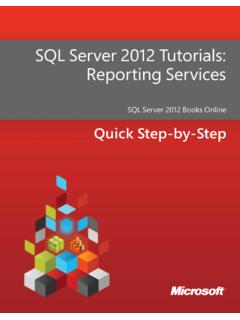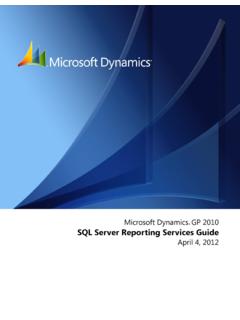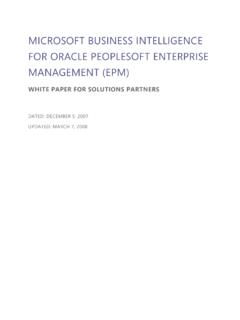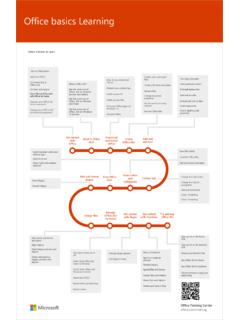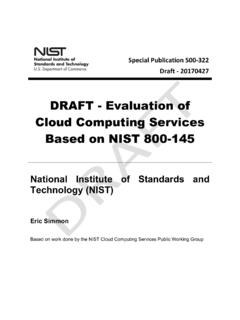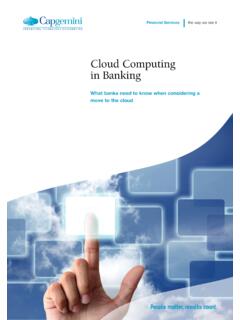Transcription of Cloud Computing and Sustainability
1 In collaboration withCloud Computing and Sustainability : The Environmental Benefits of Moving to the Cloud 2 Executive Summary 2 Introduction: Is the Cloud a Greener Computing Alternative? 3 Research Approach 4 Summary Findings 5 How Does Cloud Computing Reduce Environmental Impacts of IT? 6 Dynamic Provisioning 6 Multi-Tenancy 7 Server Utilization 7 Data Center Efficiency 8 Other Important Factors 8 Case Study Global Consumer Goods Company 10 Conclusion & Outlook 11 Expanding the Cloud 11 Further Improvements 11 Appendix 122 Cloud Computing large-scale, shared IT infrastructure available over the internet is transforming the way corporate IT services are delivered and managed. To assess the environmental impact of Cloud Computing , Microsoft engaged with Accenture a leading technology, consulting and outsourcing company and WSP Environment & Energy a global consultancy dedicated to environmental and Sustainability issues to compare the energy use and carbon footprint of Microsoft Cloud offerings for businesses with corresponding Microsoft on-premise deployments.
2 The analysis focused on three of Microsoft s mainstream business applications Microsoft Exchange , Microsoft SharePoint and Microsoft Dynamics CRM. Each application is available both as an on-premise version and as a Cloud -based The team compared the environmental impact of Cloud -based vs. on-premise IT delivery on a per-user basis and considered three different deployment sizes small (100 users), medium (1,000 users) and large (10,000 users). The study found that, for large deployments, Microsoft s Cloud solutions can reduce energy use and carbon emissions by more than 30 percent when compared to their corresponding Microsoft business applications installed on-premise. The benefits are even more impressive for small deployments: Energy use and emissions can be reduced by more than 90 percent with a shared Cloud service.
3 Several key factors enable Cloud Computing to lower energy use and carbon emissions from IT: Dynamic Provisioning: Reducing wasted Computing resources through better matching of server capacity with actual demand. Multi-Tenancy: Flattening relative peak loads by serving large numbers of organizations and users on shared infrastructure. Server Utilization: Operating servers at higher utilization rates. Data Center Efficiency: Utilizing advanced data center infrastructure designs that reduce power loss through improved cooling, power conditioning, etc. Though large organizations can lower energy use and emissions by addressing some of these factors in their own data centers, providers of public Cloud infrastructure are best positioned to reduce the environmental impact of IT because of their scale.
4 By moving applications to Cloud services offered by Microsoft or other providers, IT decision- makers can take advantage of highly efficient Cloud infrastructure, effectively outsourcing their IT efficiency investments while helping their company achieve its Sustainability goals. Beyond the commonly cited benefits of Cloud Computing such as cost savings and increased agility Cloud Computing has the potential to significantly reduce the carbon footprint of many business applications. Executive Summary The Cloud s unprecedented economies of scale reduce overall cost and increase efficiencies, especially when replacing an organization s locally operated on-premise1 servers. But does this advantage also translate to environmental benefits?
5 3 Both Cloud Computing and Sustainability are emerging as transformative trends in business and society. Most consumers (whether they are aware of it or not) are already heavy users of Cloud -enabled services, including email, social media, online gaming, and many mobile applications. The business community has begun to embrace Cloud Computing as a viable option to reduce costs and to improve IT and business agility. At the same time, Sustainability continues to gain importance as a performance indicator for organizations and their IT departments. Corporate Sustainability officers, regulators and other stakeholders have become increasingly focused on IT s carbon footprint, and organizations are likewise placing more emphasis on developing long-term strategies to reduce their carbon footprint through more sustainable operations and Cloud service providers are making significant investments in data center infrastructure to provide not only raw Computing power but also Software-as-a-Service (SaaS) business applications for their customers.
6 New data centers are being built at ever-larger scales and with increased server density, resulting in greater energy consumption. The Smart 2020 report4 Enabling the Low Carbon Economy In the Information Age estimates that the environmental footprint from data centers will more than triple between 2002 and 2020, making them the fastest-growing contributor to the Information and Communication Technology (ICT) sector s carbon footprint. It stands to reason that consolidating corporate IT environments into large-scale shared infrastructure operated by specialized Cloud providers would reduce the overall environmental impact and unlock new efficiencies. But does this assumption pass the test of a quantitative assessment on a per-user basis?
7 Considerable research has been dedicated to understanding the environmental impact of data centers and to improving their However, the aggregate Sustainability impact of choosing a Cloud -based application over an on-premise deployment for the same application has not been rigorously analyzed. For example, how might a CRM solution for 1,000 sales agents reduce the overall environmental footprint when it is run in the Cloud versus on a company s own servers? Is there a net benefit of moving to the Cloud , or are we simply outsourcing the environmental impact to a service provider? This Microsoft-sponsored study is targeted at answering these kinds of : While this research focuses on direct carbon reduction benefits of the Cloud , it is also important to mention potential indirect benefits of Cloud Computing beyond the scope of this study.
8 Like broadband and other technologies provided by the ICT sector, Cloud Computing is emerging as a viable, scalable technology that can help significantly reduce carbon emissions by enabling new solutions for smart grids, smart buildings, optimized logistics and dematerialization. The Smart 2020 report estimates the potential impact of ICT-enabled solutions to be as much as 15 percent of total global carbon emissions (or billion tons of CO2 equivalents per year). Broad adoption of Cloud Computing can stimulate innovation and accelerate the deployment of these enabled solutions. Consequently, Cloud Computing may have a major impact on global carbon emissions through indirect benefits in addition to the direct savings from replacement of on-premise infrastructure which are analyzed : Is the Cloud a Greener Computing Alternative?
9 4 Building upon previous analysis work with Microsoft,6 Accenture and WSP Environment & Energy developed a quantitative model to calculate the energy use and carbon footprint of an organization s IT applications for both Cloud and on-premise deployment. This approach aligns with the assessment methodology developed by the Global e- Sustainability Initiative (GeSI),7 the industry consortium promoting Sustainability on behalf of leading ICT companies. The model quantifies energy use and carbon emissions on a per-user basis. To account for the fact that on-premise server counts do not follow a linear scale as user counts increase, the research analyzes the impact among three different sizes of user groups: small (100 users), medium (1,000 users) and large (10,000 users).
10 Specific input data utilized by the research team included the following (also see the Appendix for more detailed information): User Count: Number of provisioned users for a given application. Server Count: Number of production servers to operate a given application. Device Utilization: Computational load that a device (server, network device or storage array) is handling relative to the specified peak load. Power Consumption per Server: Average power consumed by a server. Power Consumption for Networking8 and Storage: Average power consumed for networking and storage equipment in addition to server power consumption. Data Center Power Usage Effectiveness (PUE): Data center efficiency metric which is defined as the ratio of the total data center power consumption divided by the power consumption of the IT equipment.



